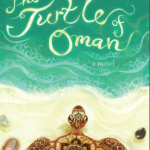A version of this review ran in The Rivard Report.
An unexpected gift
On the Wednesday morning before a Thanksgiving weekend in Big Bend National Park, the poet and novelist Naomi Shihab Nye dropped off a signed copy of The Turtle of Oman, her recently published novel, for my daughters.
Touched by this unexpected gift, I packed the book for our trip with the rest of our camping gear.
Would my kids like this?
My nine year-old wants magic in her literature.
She has reread the seven Harry Potters so many times the binding glue has cracked on most of them and whole chapter-chunks of the books’ spines split away.
To satisfy her appetite for magic, we’ve read The Hobbit to her, and we’re halfway through Susan Cooper’s The Dark Is Rising series.
But I did not know how she would take to the slower magic of a boy’s relationship with his grandfather, and the growing heartache of saying goodbye to home.
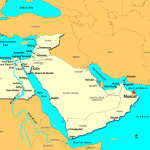
Reading about Oman in Big Bend National Park
I began reading The Turtle of Oman out loud to my four year-old and nine year-old while driving through the mountains-of-the-moon landscape of Big Bend. We drove and then hiked past water, mountains, and desert.
Aref Al-Amri, an Omani boy, procrastinates before a move from the capital city Muscat in Oman, to Ann Arbor, Michigan, through list-making and serendipitous adventures with his grandfather Sidi.
Although we don’t learn Aref’s precise age, in my mind Aref is the same age as my nine year-old.
Aref plays with Legos, competes in a youth soccer league, and studies in two languages, English and Arabic.
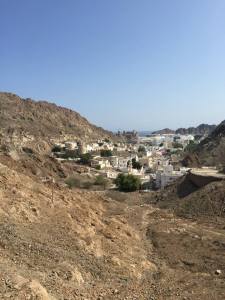
I was struck at just how familiar Aref’s boyhood world would be to American children like my daughters. The familiarity stems not just from the Legos and the soccer, but also from his struggle with saying goodbye to a place he loves.
Nye captures and helps us meditate on the boy’s emotional journey.
Mountains, deserts, stones
The further we drove, and the more I read, the more familiar Oman began to seem. I paused between chapters to gaze out of our car window.
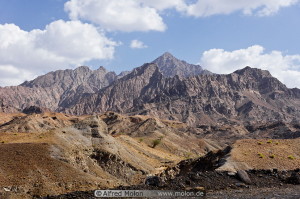
We learn that Omanis revere the Hajar (or “Stone”) Mountains from Muscat. Have you seen pictures of these mountains? I swear I saw them in Big Bend.
As Aref and Sidi travel by Jeep into the shifting sands of the Omani desert for an overnight adventure, we sped through parched desert ourselves.
Sidi and Aref watch Bedouin camel caravans on the edge of the sandy horizon, just as we scanned the distant mesas from our campsite for imaginary Comanches, hidden just over the cliff border with Mexico.
Nye’s poetic eye lingers on a stone discovered by Sidi with three circular lines like map-route tracings. On our hike in Tuff Canyon, my four year-old stooped to grasp and inspect volcanic rocks, pockmarked and rust-colored.
Peregrine falcons
During dinner at Chisos Basin lodge in the middle of Big Bend, we learned that the peregrine falcon is the fastest animal on the planet, reaching maximum speeds of 220 miles per hour. Peregrine falcons kill prey instantly upon impact. Importantly, a few pairs of peregrine falcons nest in Big Bend near the Rio Grande River.

In the novel’s most thrilling scene, a falcon trainer in the desert fits Aref with the leather armband needed to launch into the air and receive back a trained peregrine falcon. Sidi holds his breath as the predator turns precise aerial acrobatics at shocking speed. When the falcon lands cleanly on Aref’s arm, Sidi breathes again.
Breathing
Later, Sidi urges Aref to breathe for another reason.
“Sidi kept sniffing and urging Aref to smell the air and breathe deeply. ‘That way, your body will carry the desert back to the city,’ he said. Aref gulped and held his breath.
When they turned around and started walking back to the NIGHT OF A THOUSAND STARS desert camp, Aref stared at the whole picture before them – small tents, purple pom-pom doorways, brown stucco bathroom, painted green stools, metal tables, and one tired sleeping falcon. Everything glistened, an oasis in the sun. He ran circles around Sidi, saying ‘I love this place! I think it might be my favorite place!
‘You will be like my falcon,’ said Sidi. ‘You will fly away and come back. Just as he did. That was beautiful.’ “
The stars at night
At night at Big Bend, snug in our sleeping bags, crowded into our tent, my girls asked me to read aloud more chapters about the Omani boy, Aref.
At least once every night out in Big Bend, I left our tent to breathe deeply, look up at the bedazzled black, to silently recite Emerson:
“If the stars should appear one night in a thousand years, how would men believe and adore, and preserve for many generations the remembrance of the city of God which had been shown!”
When Aref and Sidi leave their desert encampment, Sidi shows his playful side again:
“As they were passing under the arched NIGHT OF A THOUSAND STARS sign at the camp gateway, Aref said, ‘So, Sidi, did you see a thousand stars last night?’
‘Ah, now you remember to ask! No, I only saw nine hundred and ninety-nine. So we will have to keep our eyes open for that last one. What about you?’
Aref just laughed.”
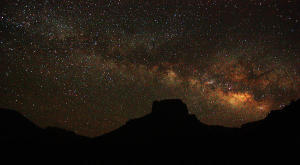
Not the coming-to-America story we expected
This crescent-moon of a novel waxes nostalgic as Aref’s departure approaches. We expect a typical novel’s narrative arc. We expect to learn about the cultural adventures of an Omani boy arriving in Ann Arbor, Michigan. Instead, two-thirds of the way through the novel, we realized the now-full moon has begun to wane again. In fact, he won’t arrive in Ann Arbor before the novel ends.
Aref is our window into understanding Oman, not America. An Omani boy learning about Michigan is not part of Nye’s plan. The Turtle does not conform.
Naomi Shihab Nye’s reason for that
Aref’s story offers something rarer, something different. Could American children connect with the magic of a childhood in Oman?
I thought about Nye’s plan because of a short story of Nye’s which I recently read when it went viral on Facebook, called “A-4.”
In “A-4,” Nye comforts a Palestinian woman in distress at the Albuquerque airport over a missed airline connection. She finds the woman in full Palestinian traditional garb, crumpled on the floor crying.
The ‘other’ becomes familiar
We’ve watched the news enough to react to a wailing Palestinian woman with some anxiety.
As Nye gently writes in “A-4,” she hesitated before getting involved because, “Well – one pauses these days.”
But in “A-4,” crying turns to laughter, handholding, and hours of shared happiness in the airline terminal. Nye offered a few words in Arabic, and received a gift of a powdered sugar-dusted cookies. Nye marvels at the experience, the common humanity.
The other passengers at the gate soon dropped their normal defenses as well, allowing the shared cookies’ powdered sugar – a kind of peace dust – to coat their laps.
“A-4” hits people somewhere between recognition – we’ve had this surprise connection to strangers when our defenses suddenly drop – and longing – we wish this could happen more often.
I think Nye shares a wish for our children with The Turtle of Oman that she states most clearly in “A-4:”
“…I looked around that gate of late and weary ones and I thought, This
is the world I want to live in. The shared world. Not a single person in that
gate – once the crying of confusion stopped – seemed apprehensive about
any other person. They took the cookies. I wanted to hug all those other
women, too.
This can still happen anywhere. Not everything is lost.”
Could we find our common humanity if we immersed ourselves in another culture? And if not all of us, could our children?
What if we watched a peregrine falcon in flight over the desert, together?
My nine year-old finished the final third of the book on her own during the drive home from Big Bend, too wrapped up in the story to wait for me to read it to her.
The slow magic of this book, with its vivid colors and poet’s eye for detail, worked on her.
Please see related post:
Book Review of Going Going by Naomi Shihab Nye
Please see related post All Bankers Anonymous book reviews in one place.
Post read (1493) times.


